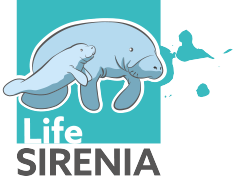Preparation

Preparing for the opening of a pre-release enclosure
![]()
The project provides for the construction of a pre-release enclosure to ensure a better transition of the calves from the rearing pool to the natural environment.
A construction study is necessary to achieve this. It will enable the selection of the best site and to develop construction plans for the enclosure, as well as to choose the materials and the contractor. Permission will then be requested to construct and open these facilities.
The pre-release enclosure must be able to accommodate all the animals targeted for release under ideal conditions, ensuring their vitality in the natural environment (food, fresh water, water quality), their safety and the safety of the technical staff.

Preparing for the opening of a care centre
![]()
Several types of facilities exist to support and care for manatees today in the Caribbean and in zoos ensuring their care. The size of these facilities and their use of the water differ, and choices in terms of medical and operational equipment must be made in order to make the care given to the animals as effective as possible.
In order to determine the scientific and technical feasibility of the facilities, full specifications will be established by developing the initial plans and sketches of the pool. A prime contractor will then work on the specific development of the plans, choose the materials and the companies to carry out the construction of the centre.

Ensuring the procurement, transport and import authorisations of new animals
![]()
Procuring the animals
Missions of discussion and cooperation will be organised in order to ensure the procurement and the transfer of new animals to Guadeloupe. They will enable discussions for the possibilities of donations of animals and their technical and operational feasibility, by meeting with the organisations that hold Antillean manatees in captivity.
An important aspect of this phase will be the genetic characterisation of pre-identified animals. The individuals will be selected by the expert group after genetic analyses, in order to maximise the genetic variability of the founder population and to avoid inbreeding depression. In order to find new sources of donations of animals, a study will also be conducted in order to assess the captive population of manatees in the Caribbean.

Transporting the manatees
The transport of the animals will be carried out by specially dedicated cargo aircraft. The manatees will be placed in impervious wooden crates equipped with a humid mattress at the bottom and filled with a layer of water a few centimetres deep. The manatee will be humidified and its vital parameters observed throughout transport.
In order to ensure the continuity and the proper conduct of transport, a team will be present during the entire journey.
Preparing the establishment of a participatory manatee monitoring network
![]()
For any reintroduction project, the establishment of a monitoring network is essential after the release of animals. Preparation is nevertheless necessary: the monitoring protocols must be rigorous and adapted to the territory and its constraints, and the monitoring teams must be operational.
Several studies and training days will be conducted
- an internal feasibility study in order to define the necessary monitoring protocols and to ensure the effectiveness of the sea missions
- a one-day workshop with volunteer fishermen and Park officers to finalise setting up the network
- training for the officers and fishermen to use the monitoring protocols and forms, as well as the radio-tracking equipment
- training for the charter of good conduct, the observation forms and the conduct to take in the event of an anomaly for the other users of Grand Cul-de-Sac Marin who may encounter animals
- the presentation of the project to the neighbouring islands and the search for partnerships in case of the escape of a manatee to their waters


 Our Actions
Our Actions